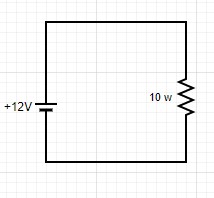As we know, resistor is an electrical material which can resist the flow of electric current or electron. We have already discuss about resistor much more. Visit these link for more valuable What is resistor? and resistor color code. Here we are going to discuss about " what is the potential difference across the 10 w resistor? ". There are different types of resistor available in the market. They are :- 1. Carbon resistor, 2. Film resistor, 3. Fusible resistor, 4. Variable resistor, 5. Wire wound resistor. Resistor is passive component and made of different material like glass, conductor, clay, or combination of these. Generally, resistor is used for voltage divider, current limiter, heat dissipation etc.
Resistor acts as voltage divider as well as current divider. For parallel connection, resistor will act as current divider and for series connection, resistor acts as voltage divider. Let's calculate the potential difference (P.D.) between the different form of resistor. Then we will discuss about resistor more.
what is the potential difference across the 10 w resistor ?
10 w resistor means the resistor which has 10 watt power. 10 watt power means the product of current and voltage is 10 (in DC and AC case ). The range value of current and voltage is given by manufacture so that this resistor can be used in that range only. Otherwise, this will blown out.
And we have to know that resistor has two type of property i.e. resistance and power dissipation. Resistance means the property of resistor that resist the flow of current or electron whereas power dissipation means how much power it can dissipate to the system or how much heat/power it can produce without damage. As we know, resistor can be used as a heating element so here given resistor is quite different than 10 ohm resistor. Don't confused on that.
We know,
voltage = current x resistance
V = IR
and, Power (P) = voltage x current
= VI
= V² / R [∵ I = V / R ]
= I²R [∵ V = IR]
Also,
R = V²/P
= P/I²
From above, resistance may varies for same power for different voltage and current source on a circuit.
We are going to calculate PD for different cases.
Case 1:- Single resistor
Let's consider, there is a voltage source of 12 V and 10 ω resistor as a load in a circuit.
At that case, the voltage (potential difference) across the resistor is 12 V because there is only one resistor so voltage is not divided.
For another source of 24V with that 10 ω resistor as a load and for that the potential difference across it is 24 V.
But in both case, calculate resistance as below,
R = V² / P
For 12 V, Resistance R = 12² / 10 = 14.4 ohm
For 24 V, Resistance R = 24² / 10 = 57.6 ohm
As we can see for same power resistor, resistance of that resistor is difference with voltage source. On both case, that resistor will dissipate same amount of heat. For that power, its resistance may vary with voltage and current source.
Also, we can calculate current,
For 12 V, Current I = P / V = 10 / 12 = 0.833 A
For 24 V, Current I = 10 / 24 = 0.4167 A
It can also calculate from ohm law by, I = V / R = 12 / 13.4 = 0.833 A (For 12 V)
Case 2:- Double resistor (parallel connection)
Let's consider, there is a voltage source of 12 V and 2 resistor of 10 w power as a load in parallel connection in a circuit.. At that case, potential difference across the 10 w resistor is also 12 V because both of them are in parallel connection. We know voltage is divided only in series condition not in parallel connection. Current will divided in parallel connection.
If the voltage source is different then the potential difference across that resistor will also different for that case which is equal to the source voltage.
Calculate resistance and current as below,
R = V² / P
For first resistor, Resistance R1 = 12² / 10 = 14.4 ohm
For second resistor, Resistance R2 = 12² / 10 = 14.4 ohm
Total equivalent resistor, 1 / R = 1 / R1 + 1 / R2
or, 1 / R = 1 / 14.4 + 1 / 14.4
or, 1 / R = 0.1389
∵ R = 7.2 ohm
Total current,
I = V / R
= 12 / 7.2
= 1.67 A
For first resistor, Current I1 = I x R2 / (R1 + R2)
or, I1 = (1.67 x 14.4) / 28.8
or, I1 = 0.835 A
Similarly for second resistor, I2 = I x R1 / (R1 + R2)
or, I2 = 0.835 A
Case 2:- Double resistor (Serial/series connection)
Let's consider, there is a voltage source of 12 V and 2 resistor of 10 w power as a load in series connection in the circuit. At that case, potential difference across the 10 w resistor is different for both resistor, which need to be calculate but both of them having same current.
Now, total power ( P ) = (P1 x P2) / (P1 + P2) = (10 x 10) / (10 + 10) = 5 w
Now total resistance, Resistance R = V² / P = 12² / 5 = 28.6 ohm
For series connection, total resistance, R = R1 + R2 = 28.6 ohm
For first resistor, R1 = R x P1 / (P1 + P2)
or R1 = (28.6 x 10) / 20
∵ R1 = 14.3 ohm
Similarly for second resistor, R2 = R x P2 / (P1 + P2)
= 14.6 ohm
Total current, I = P / V
= 5 / 12
= 0.417 A
Now calculate potential difference across the 10 ω resistors,
For first resistor, V1 = V x R1 / ( R1 + R2)
or, V1 = (12 x 14.3) / (14.3 + 14.3)
∵ V1 = 6 V
For second resistor, V2 = V x R2 / (R1 + R2)
= 6 V










No comments:
Post a Comment
----Please share your opinion with us-----